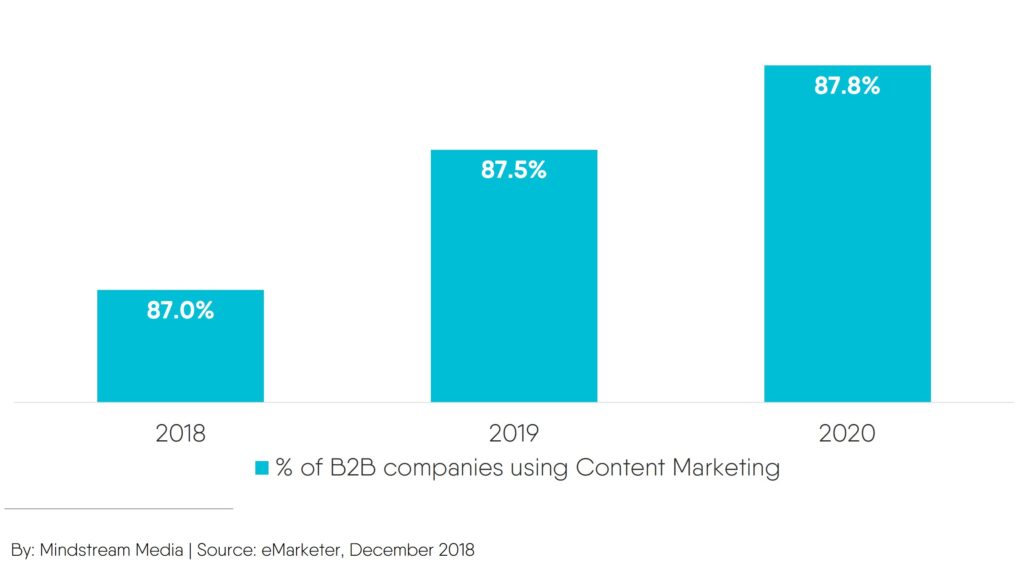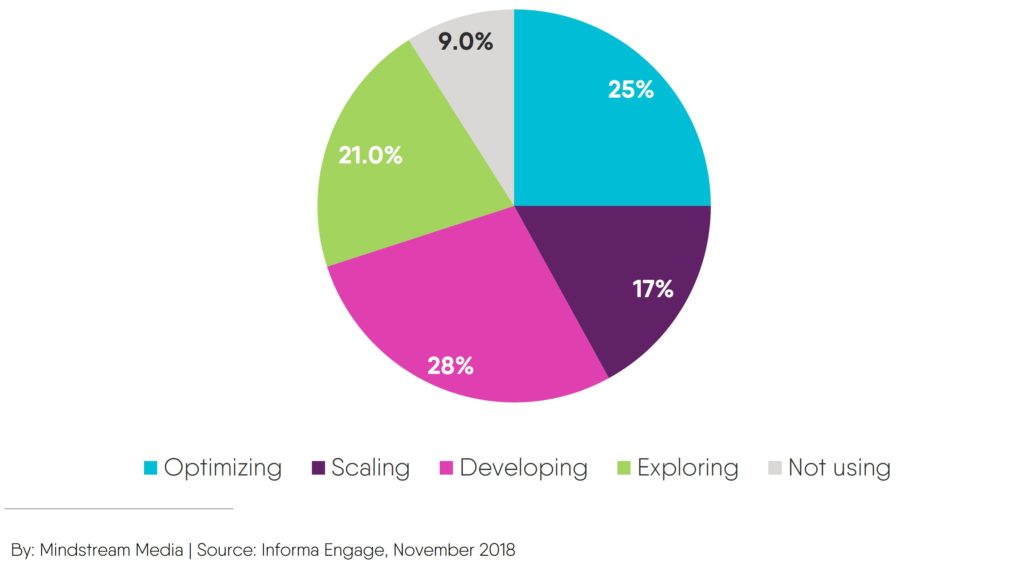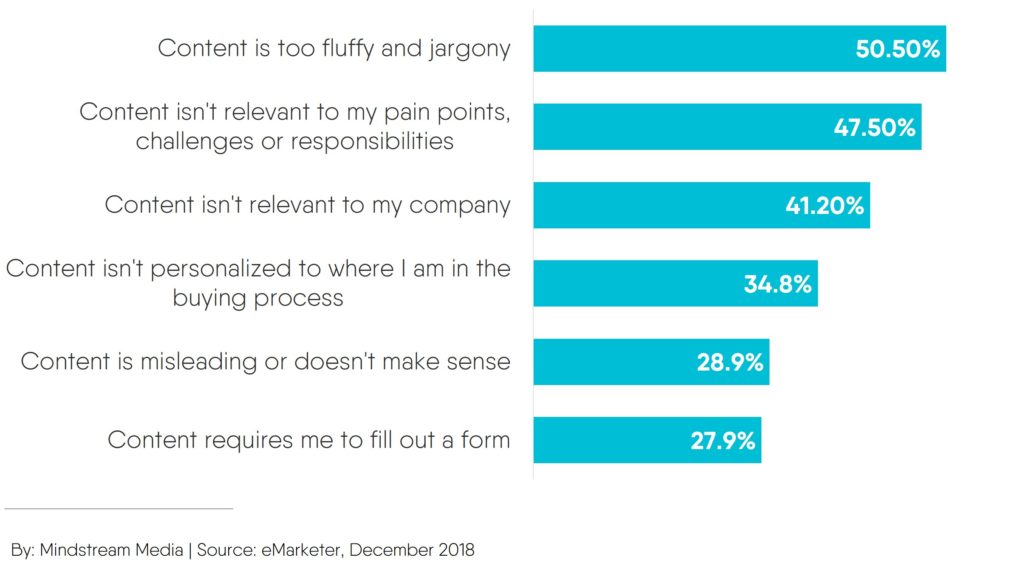How to Avoid 5 Devastating B2B Content Marketing Mistakes
This week, eMarketer released a study on the state of B2B Content Marketing that was packed with interesting stats for marketers. One of the study’s most significant findings was the overwhelming amount of B2B companies that currently use content marketing.
B2B Content Marketing usage

With almost nine in 10 B2B companies currently using content marketing, the practice may be reaching a saturation point. And, companies are using Content Marketing for a variety of business objectives. eMarketer kicked off the report by stating:
Content is more than an upper funnel, lead generation device. When crafted with purpose and intent, strategic content can influence audience behavior throughout the B2B customer journey.
I agree wholeheartedly. In fact, I recently gave a presentation at LSA19 about that very point (check out the SlideShare below).
Related – The Role of Organic Content in the Consumer Buying Journey
Organic content is an effective way to inspire profitable consumer action throughout the journey when it’s done right. But when it’s done wrong, content can fall flat. Less pragmatic marketers may see initial B2B Content Marketing failures as an indictment against the practice itself, rather than a symptom of faulty tactics.
The truth is, despite this saturation, B2B Content Marketing efforts still haven’t hit full maturation. eMarketer also noted a study that asked B2B marketers about the level of their Content Marketing maturity, and the results were scattered across the board.
B2B Content Marketing maturity level in the United States

B2B Content Marketing pros aren’t the only ones to recognize the growing pains. eMarketer’s report also identified the biggest issues that B2B decision makers (i.e., your audience) have with the content they receive.

If your brand is still working on growing your Content Marketing efforts, here’s what you can do to avoid five of the pitfalls mentioned above.
No. 1: Content is too fluffy and jargony
In order to effectuate consumer action, Content Marketing efforts must create synergy and catalyze a paradigm shift across the organization.
Did your head hurt reading that sentence as much as mine did writing it? That’s because it’s a useless heap of fancy-sounding words incoherently meshed together. Regular consumers don’t want to read it and neither do B2B audiences. To keep your audiences happy, make sure the content you put out is free from fluff and jargon.
No. 2: Content isn’t relevant to my pain points, challenges or responsibilities
“People don’t want to buy a quarter-inch drill bit. They want a quarter-inch hole.” Click To TweetOne way I see this play out all too often is when brands focus their content on a product’s features rather than its benefits. B2B companies have a habit of getting so wrapped up in how their products work that they forget why people buy them – for the benefits they provide.
I’m not the biggest fan of using random quotes to prove specific points but Seth Godin outlined an interesting way to look at this problem in his book This is Marketing:
Theodore Levitt, a Harvard marketing professor, famously said, “People don’t want to buy a quarter-inch drill bit. They want a quarter-inch hole.” But we can take this further: someone wants the hole so they can put a shelf on the wall; which lets them keep their stuff tidy and on display; and, they want to feel good about doing it themselves.
In other words: “People don’t want to buy a quarter-inch drill bit. They want to feel safe and respected.” They don’t want the thing you have made, they want what it will do for them and how it will make them feel.
No.3: Content isn’t relevant to my company
If you serve multiple audiences (e.g., different target audiences for different product lines), you’ll probably end up creating content pieces that aren’t relevant to everyone. And that’s OK. The important thing is to try to segment your audiences so they’re only seeing the content that’s most relevant to them. For example, if you’re incorporating email into your B2B Content Marketing strategy (and you definitely should), group your email list by industry and create content for specific audience segments.
No. 4: Content is misleading or doesn’t make sense
This is one I see frequently when brands farm out their content creation to freelancers. I’m not saying all freelancers are bad. I’m just saying you get what you pay for when it comes to content. If a freelancer comes to you with pricing that sounds too good to be true, it probably is. If you go outside your company for content, make sure to hire a reputable marketing agency or well-vetted freelancers.
No. 5: Content requires me to fill out a form
Here’s a marketing paradox: what happens when an unstoppable force like marketing best practices crashes into an immovable object like consumer preferences? Well, first of all, that shouldn’t happen. Best practices should be based on what consumers want, but contact forms fall into somewhat of a gray area. Gating content allows B2B marketers to gather information from potential customers so they can contact them later on. But, sometimes business consumers just want to access a piece of content without having to surrender their personal information (and deal with the inevitable follow up emails and sales calls).
I’ve been on both sides of this and have some strong feelings on it, some of which may not sit well with other marketers. Here are a few of my thoughts on how your brand should handle this clash of interests:
- If you use a form, the content behind it had damn well better be worth the consumer’s time to read it. (On that note, I don’t care if you bring in J.K. Rowling to write it, no blog post is worth filling out a form.)
- If a consumer fills out a form, they’re entrusting you with their personal information – be responsible with it and respectful of it.
- Filling out a generic form and consuming a piece of content is not an open invitation to call someone repeatedly. Sometimes people just want to read something, don’t harass them for it.
In that spirit, if you’d like to learn more ways to improve your B2B content marketing strategy, fill out the form below. We’d be happy to start a conversation about how our Content Marketing solution can help amplify your brand’s content efforts.
More from Mindstream Media Group

Meet the Mindstreamer – Chandler Swanner
Chandler Swanner’s interest in advertising dates back to her childhood. Her mother (and role model in life) was a Media […]

Third-Party Cookie Phase-Out: What Marketers Need to Know
Cookies are an essential part of internet usage, allowing websites to remember you and provide a more personalized experience. This […]

Meet the Mindstreamer – Kaya Bucarile
She plans and oversees media strategy for agency clients, working closely with project and platform managers to ensure that we […]
